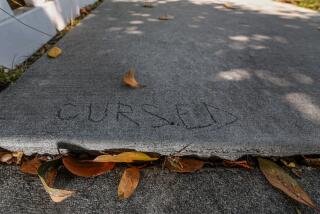Inferior Tunnel Braces Cited in Ground Sinkage
The use of inferior materials for the bracing of subway tunnels contributed to surface sinkage last month along Hollywood Boulevard, transit officials confirmed Monday.
Two years ago, project engineers had allowed the tunnel builder to use wood wedges for bracing, instead of steel struts. But the wood was crushed last month during the ground sinkages, and samples of the wood have failed strength tests.
Franklin E. White, chief executive officer of the Metropolitan Transportation Authority, announced Monday that he would retain âan outside construction specialistâ by the end of the week to investigate how and on what basis the materials were used.
âI would say to you that this has shaken terribly my confidence in the construction firm and the firms supervising the construction for us,â White said.
Representatives of the construction firm, Shea-Kiewit-Kenny, were unavailable for comment.
The MTA relies on the Pasadena-based firm of Parsons-Dillingham to inspect the construction. Decisions regarding which materials are permissible for the subway construction generally are left to a group of private engineering firms, led by the company of Parsons Brinckerhoff of New York.
In Pasadena, a spokesman for Parsons-Dillingham said the management firm âlooks forward to an independent investigation of the situation by a qualified, outside organization.â
Last October, White hired two groups of specialists to review the construction of Downtown subway tunnels now open to passengers. Those experts concluded that areas of the tunnels were built with concrete thinner than specified and needed repairs, and that Parsons-Dillingham had fallen short of âacceptable industry practiceâ in supervising the work.
White said Monday that he first learned of the potential problem with the bracing of the Hollywood tunnels one week ago after inquiries by The Times.
Records show that in September, 1992, transit engineers allowed the tunnel builder to use 32-inch-long wood wedges for bracing in expansion gaps between segments of a precast concrete shell that forms the tunnelâs outer liner. Originally the contract required use of metal struts in the gaps.
Even though project officials authorized the substitution of the wood wedges, records show that the specifications still required Shea-Kiewit-Kenny to place concrete or a non-shrink grout material into the gaps. The contract required that the concrete or grout be placed no later than 16 hours after insertion of the tapered four-inch-wide wedges.
On Monday, hours after The Times asked whether the concrete or grout had been properly placed, MTA chief White announced that he was launching an investigation of the entire matter.
âPreliminary test results on some sample (wood) wedges have indicated that the wood actually used failed to meet its specified strength and that accompanying concrete in the gap may not have been properly placed or met design specifications,â said an MTA press release.
Shea-Kiewit-Kenny won approval to substitute the wood for metal struts on the basis that the new material would have a compressive strength of 1,556 pounds per square inch, according to contract documents. The new material was supposed to be oak or âequivalent hardwood.â But experts said that specification exceeds the strength of oak.
âWe are investigating whether we got the wood that was approved for use, and that it was as strong as it was supposed to be,â White said. âWe also will review the decision to substitute the wooden wedges and the supervision of the installation of them.â
An MTA âTunnel Review Boardâ report prepared by the projectâs chief tunnel designer and distributed Sept. 1 cited the crushing of the wood wedges as part of the âimmediate causeâ of the ground sinkages along Hollywood Boulevard. Those sinkages, ranging from one to nine inches, have damaged utilities and buildings. Tunneling has been halted since Aug. 18.
The crushing of the wedges and weakening of eight-inch-thick segments of concrete caused a Shea-Kiewit-Kenny superintendent Aug. 20 to evacuate one of the twin tunnels out of fear that it was collapsing.
Records show that the chief tunnel designer, Timothy P. Smirnoff of Parsons Brinckerhoff, was one of two project officials who approved the use of wood wedges. Smirnoff, reached Monday night, declined to comment.
The Times reported Sept. 11 that roughly 340 linear feet of tunnel was constructed in the area of sinkages without another procedure, âcontactâ grouting, required by the contract.
The article also reported that top MTA officials did not require Shea-Kiewit-Kenny to comply with the grouting requirement until last March, after more than one-third of the structures had already been excavated.
Edward McSpedon, the president of rail construction for the MTA, has told MTA board members that ground sinkages of one to two inches are to be expected in subway construction. But a 1992 report prepared for McSpedonâs staff by Degenkolb Structural Engineers stated that âthe settlement is expected to range from 1/16 (inch) to 1/4 (inch) along Hollywood Boulevard.â
More to Read
Sign up for Essential California
The most important California stories and recommendations in your inbox every morning.
You may occasionally receive promotional content from the Los Angeles Times.











